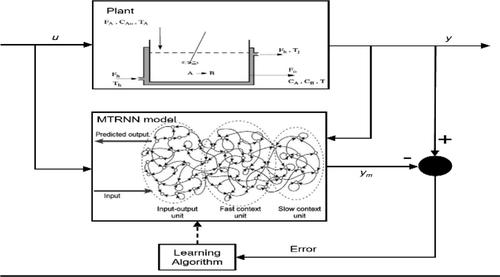当前位置:
X-MOL 学术
›
Ind. Eng. Chem. Res.
›
论文详情
Our official English website, www.x-mol.net, welcomes your
feedback! (Note: you will need to create a separate account there.)
Data-Based Modeling of a Nonexplicit Two-Time Scale Process via Multiple Time-Scale Recurrent Neural Networks
Industrial & Engineering Chemistry Research ( IF 3.8 ) Pub Date : 2022-06-22 , DOI: 10.1021/acs.iecr.2c00797 Ngiam Li Jian 1 , Haslinda Zabiri 1 , Marappagounder Ramasamy 2
Industrial & Engineering Chemistry Research ( IF 3.8 ) Pub Date : 2022-06-22 , DOI: 10.1021/acs.iecr.2c00797 Ngiam Li Jian 1 , Haslinda Zabiri 1 , Marappagounder Ramasamy 2
Affiliation

|
Modern chemical process plants are typically very complex in nature due to the various material and energy recycling streams, including the implementation of process intensification in order to improve the sustainability factor. Looking at each individual unit operation, there are inherent nonlinear properties that may often involve physical and chemical phenomena occurring on different time scales. In addition, there exist chemical processes that also inherently have dynamics that are multi time-scale in nature. However, designing the control system for those integrated and intensified processes poses significant difficulties because they naturally lead to the dynamics of the network having multiple time-scale behaviors and a reduced number of degrees of freedom. The status quo approach to handle multiple time scales would be to separate the plant-wide dynamics into their fast and slow components and implement a hierarchical control structure, but the current practices would lead to computational issues when being applied to model-based controllers due to the inversion of ill-conditioned and stiff differential algebraic equation models under large time-scale separation. To address this issue, this study proposes an alternative approach to modeling multi time-scale processes based on the use of multiple time-scale recurrent neural networks (MTRNNs). The analysis is demonstrated via a benchmark multi time-scale continuous stirred tank reactor (CSTR) case study, using input–output data generated via simulation of nonlinear dynamical equations of the CSTR with large parameters (reciprocal of the singular perturbation small parameter) in the form of 1/ε as the large heat transfer coefficient. The MTRNN model is constructed with groups of neuronal nodes grouped together based on their assigned time constant (also known as decay rate), which leads to an improved prediction performance when compared to other common modeling methods. The prediction performance of the proposed MTRNN model when applied to the multi time-scale CSTR results in an R2 value of 0.9997, in addition to an average of 75 times lower root mean square error when compared to that of the nonlinear autoregressive network with exogenous inputs (NARX) and transfer function methods, implying its higher potential efficacy in modeling complex multi time-scale processes.
中文翻译:

通过多时间尺度递归神经网络对非显式两时间尺度过程进行基于数据的建模
由于各种材料和能源回收流,包括实施过程强化以提高可持续性因素,现代化学加工厂通常在性质上非常复杂。查看每个单独的单元操作,存在固有的非线性特性,这些特性可能通常涉及在不同时间尺度上发生的物理和化学现象。此外,存在本质上也具有多时间尺度动力学的化学过程。然而,为那些集成和强化的过程设计控制系统会带来很大的困难,因为它们自然会导致网络的动态具有多个时间尺度行为和减少的自由度数量。处理多个时间尺度的现状方法是将全厂动态分离为其快速和慢速组件并实施分层控制结构,但当前实践在应用于基于模型的控制器时会导致计算问题,因为大时间尺度分离下的病态和刚性微分代数方程模型的反演。为了解决这个问题,本研究提出了一种基于使用多个时间尺度递归神经网络 (MTRNN) 对多时间尺度过程进行建模的替代方法。该分析通过基准多时间尺度连续搅拌釜反应器 (CSTR) 案例研究得到证明,使用通过以 1/ε 形式作为大传热系数的大参数(奇异扰动小参数的倒数)模拟 CSTR 的非线性动力学方程生成的输入-输出数据。MTRNN 模型由基于分配的时间常数(也称为衰减率)组合在一起的神经元节点组构成,与其他常见建模方法相比,这可提高预测性能。提出的 MTRNN 模型在应用于多时间尺度 CSTR 时的预测性能导致 与其他常见的建模方法相比,这可以提高预测性能。提出的 MTRNN 模型在应用于多时间尺度 CSTR 时的预测性能导致 与其他常见的建模方法相比,这可以提高预测性能。提出的 MTRNN 模型在应用于多时间尺度 CSTR 时的预测性能导致R 2值为 0.9997,此外,与具有外生输入 (NARX) 和传递函数方法的非线性自回归网络相比,均方根误差平均低 75 倍,这意味着它在建模复杂的多时间-规模化进程。
更新日期:2022-06-22
中文翻译:

通过多时间尺度递归神经网络对非显式两时间尺度过程进行基于数据的建模
由于各种材料和能源回收流,包括实施过程强化以提高可持续性因素,现代化学加工厂通常在性质上非常复杂。查看每个单独的单元操作,存在固有的非线性特性,这些特性可能通常涉及在不同时间尺度上发生的物理和化学现象。此外,存在本质上也具有多时间尺度动力学的化学过程。然而,为那些集成和强化的过程设计控制系统会带来很大的困难,因为它们自然会导致网络的动态具有多个时间尺度行为和减少的自由度数量。处理多个时间尺度的现状方法是将全厂动态分离为其快速和慢速组件并实施分层控制结构,但当前实践在应用于基于模型的控制器时会导致计算问题,因为大时间尺度分离下的病态和刚性微分代数方程模型的反演。为了解决这个问题,本研究提出了一种基于使用多个时间尺度递归神经网络 (MTRNN) 对多时间尺度过程进行建模的替代方法。该分析通过基准多时间尺度连续搅拌釜反应器 (CSTR) 案例研究得到证明,使用通过以 1/ε 形式作为大传热系数的大参数(奇异扰动小参数的倒数)模拟 CSTR 的非线性动力学方程生成的输入-输出数据。MTRNN 模型由基于分配的时间常数(也称为衰减率)组合在一起的神经元节点组构成,与其他常见建模方法相比,这可提高预测性能。提出的 MTRNN 模型在应用于多时间尺度 CSTR 时的预测性能导致 与其他常见的建模方法相比,这可以提高预测性能。提出的 MTRNN 模型在应用于多时间尺度 CSTR 时的预测性能导致 与其他常见的建模方法相比,这可以提高预测性能。提出的 MTRNN 模型在应用于多时间尺度 CSTR 时的预测性能导致R 2值为 0.9997,此外,与具有外生输入 (NARX) 和传递函数方法的非线性自回归网络相比,均方根误差平均低 75 倍,这意味着它在建模复杂的多时间-规模化进程。











































 京公网安备 11010802027423号
京公网安备 11010802027423号